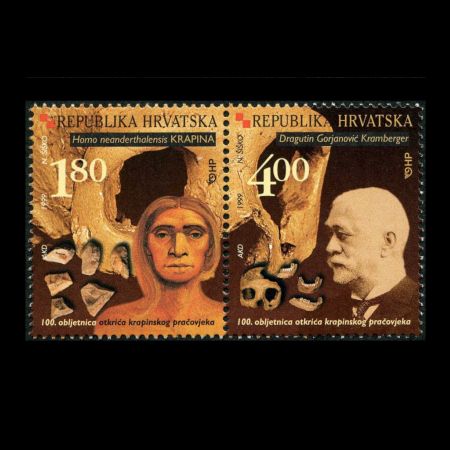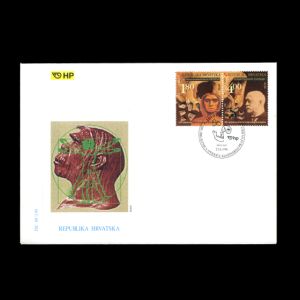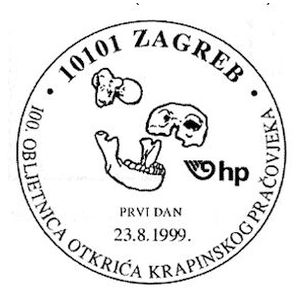Croatia 1999 "100th anniversary of the discovery of the early man from Krapina"
| <prev | back to index | next> |
| Issue Date | 23.08.1999 |
| ID | Michel: 517-518, Scott: 404a-b, Stanley Gibbons: 598-599, Yvert et Tellier: 494-495, Category: pR |
| Design | Nikola iko/Art design - graphic studio, Zagreb |
| Stamps in set | 2 |
| Value |
1.8 kn - Homo neanderthalensis, reconstruction and stone tools 4.0 kn - Portrait of Dragutin Gorjanovic-Kramberger |
| Emission/Type | commemorative |
| Places of issue | Zagreb |
| Size (width x height) | 29,82mm x 35,5mm |
| Layout | Sheet of 20 stamps |
| Products | FDC x1 |
| Paper | white 102g, gummed |
| Perforation | 14 |
| Print Technique | Multicolor offset |
| Printed by | AKD - Hrvatski tiskarski zavod, Zagreb, Savska cesta 31 |
| Quantity | 350.000 sets |
| Issuing Authority | The Croatian Post and Telecommunications |

On August 23rd 1999, Croatian Post and Telecommunications issued the set of two se-tenant stamps "100th anniversary of the discovery of the early man from Krapina". One of these stamps shows a reconstruction of a Neanderthal female person, made by Croatian artist Rudolf Laba, made on the basis of bone remnants from the cave discovered by Dragutin Gorjanovic-Kramberger.
Dragutin Gorjanovic-Kramberger, was the well-known Croatian natural scientist, geologist and palaeontologist, who discovered "strange bones" in the excavations of sand on the location called Brieg Hunjakovo in Krapina.
The remains that he found were some bones of the primitive man, traces of a fireplace, flint-stone artefacts and numerous bones of antedeluvian animals - all of these findings proving that this pre-historic site originated during the Pleistocene Epoch.
Immediately following the first excavations of the Krapina site, which lasted up to 1905, after research of previous findings, Gorjanovic-Kramberger decided that these palaeontological and archaeological remains originate during the Paleolithic, the Old Stone Age, and that they belong to the Neanderthal man who lived here in the great Last Interglacial Age, 130 thousand years ago.
The collection of the early man from Krapina is the greatest palaeontological collection ever accumulated from a Neanderthal habitat, and this is the source of a great amount of scientific information on pre-historic European people.
The collection includes remains of various body fragments, from skull bones to feet bones. Almost nine hundred bones, more or less complete, belonged to tens of different individuals, male or female persons of different ages.
Together with the human remains of the early man, the collection also contains remnants of stone artefacts, most often flint scrapers and small knives that could be ascribed to the Mousterian Neanderthal culture.
Numerous bones of extinct animals prove that there were many changes in the environment, but they also mean that the Neanderthal man was a skillful hunter and nomad. The Krapina collection of the early man is placed in the Dragutin Gorjanovic-Kramberger's Geological-palaeontological Department of the Croatian Natural Sciences Museum and is definitely the most precious holding of Croatian natural and cultural heritage as well as part of the world heritage.
Together with other findings in Central Europe, the collection can prove many regional features of evolution of European pre-historic men within the time range of almost 2000 years.
Considering the data obtained from the multitude of patterns, the Neanderthal men from Krapina within this framework represents the pivotal link and bases for the scientific concepts about the men from the geological past.
Krapina Neanderthal Museum, was opened near Krapina Neanderthal site on May 10, 1952. In 2012, Croatian Post issued a set of two stamps "Museum Of The Krapina Neanderthal Man".
Products and associated philatelic items
| FDC (official) | FDC of philatelic club of Krapina | |
 |
 |
 |
| First-Day-of-Issue Postmark | ||
 |
 |
 |
| Some personalized FDC | Stamps Sheet | First Day Sheet (with text in Croatian and French) |
 |
 |
 |
| Example of circulated covers | Krapina's Neanderthal on stamps of Croatia (PDF) | |
 |
 |
 |

|
References
Technical details and short description of the stamps:Croatian Post (English text is short, Croatian text is more detailed), Colnect, Reverse side of a Souvenir Sheet
Acknowledgements
Many thanks to Dr. Peter Voice, PhD Department of Geological and Environmental Sciences, Western Michigan University, USA, for his help in finding information and for review of a draft of this article.| <prev | back to index | next> |